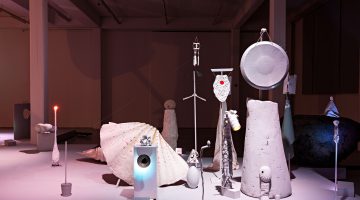Kendall George

Kehinde Wiley, Leviathan Zodiac (The World Stage: Israel), 2011. Oil and gold enamel on canvas, 115 x 79 ¾ in. (framed). Collection of Blake Byrne. Courtesy of the artist and Roberts & Tilton, Culver City, California. Kehinde Wiley | The World Stage: Israel. On view February 14–May 27, 2013. Contemporary Jewish Museum, San Francisco.
Kehinde Wiley has been making paintings of black men in Old Master’s poses with Rococo wallpaper backgrounds for over ten years now. In the early 2000s, models were singled out by Wiley on the street for their presences and poise, photographed in poses they chose from a piece of classic art history, and painted by Wiley and studio assistants. The artist and his critics positioned these works as painting about rap culture, the power of black men, the rebirth of history painting, and the triumph of marginalized faces on museum walls. The validity and positive impact of his work is established, but there are only so many times his formula could be abided with American men. In 2006 Wiley began his series, “The World Stage,” painting groups of portraits of black and brown men in India and Sri Lanka, Brazil, Lagos and Dakar, China, and Israel. “The World Stage: Israel” at the Contemporary Jewish Museum is an abridgement of the modern young Israeli man.

Kehinde Wiley, Kalkidan Mashasha II (The World Stage: Israel), 2011. Oil on canvas, 56 ⅞ x 41 ½ in. (framed). Private collection. Courtesy of Roberts & Tilton, Culver City, California. Kehinde Wiley | The World Stage: Israel. On view February 14–May 27, 2013. Contemporary Jewish Museum, San Francisco.
After the collective torture of Jews in World War II, and a New Jew was born. Also known as a Sabra, the term was defined as a gruff and hyper-masculine archetype by the Zionist movement working to amend the Jewish diaspora in newly formed Israel. The masculine ideal is pervasive and seemingly indivisible from the nation state because it is interpersonally unifying within, and an asset to, the conscripted military for which all Israelis, (with the exception of non-Jewish people of Arab ethnicity), must serve. It may be held on to so tightly because the country’s tenuous safety depends on it. The Sabra is a performance of gender, in the way that sexuality, class, and race—really most markers of identity—are.

Kehinde Wiley, Mahmud Abu Razak (The World Stage: Israel), 2011. Oil on canvas, 88 x 68 in. (framed). Private collection. Courtesy of the artist and Roberts & Tilton, Culver City, California. Kehinde Wiley | The World Stage: Israel. On view February 14–May 27, 2013. Contemporary Jewish Museum, San Francisco.
Wiley’s subjects are native born-Jews, Jews of Ethiopian extraction, and Arab Israelis. Rococo backgrounds have been swapped for leafy and zoological designs from Jewish paper cuts. More than Wiley’s template unifies the culturally diverse subjects; nearly all of the men share a typified pathos. The men’s peacocking or hardboiled expressions and poses are shallow; underneath, they have “Paris is Burning”-like uncertainty, fear, and defiance. A sabra is also a prickly pear with a sweet interior.

Kehinde Wiley, Alios Itzhak (The World Stage: Israel), 2011. Oil and gold enamel on canvas, 115 ½ x 80 ⅛ in. (framed). Collection The Jewish Museum, New York. Purchase: Gift of Lisa and Steven Tananbaum Family Foundation; Gift in honor of Joan Rosenbaum by the Contemporary Judaica, Fine Arts, Photography, and Traditional Judaica Acquisitions Committee Funds, 2011-31. Kehinde Wiley | The World Stage: Israel. On view February 14–May 27, 2013. Contemporary Jewish Museum, San Francisco.
Wiley has caught a great moment in the sociology of globalization: America’s hip-hop culture is intermingling with nations’ specific ideals and performance of male identity. This curiosity is the highlight of his paintings, and he could do without the gimmicks of country-specific frames (the portraits of Jews have the Ten Commandments carved on the top bar), and the near-photorealistic alla prima painting style in his studios (they are more Jeff Koons than Titian, like an ink jet printer). Shtick is the enemy of substance when viewing Wiley’s work.
Kehinde Wiley’s “The World Stage: Israel” is on view at the Contemporary Jewish Museum through May 27, 2013.


